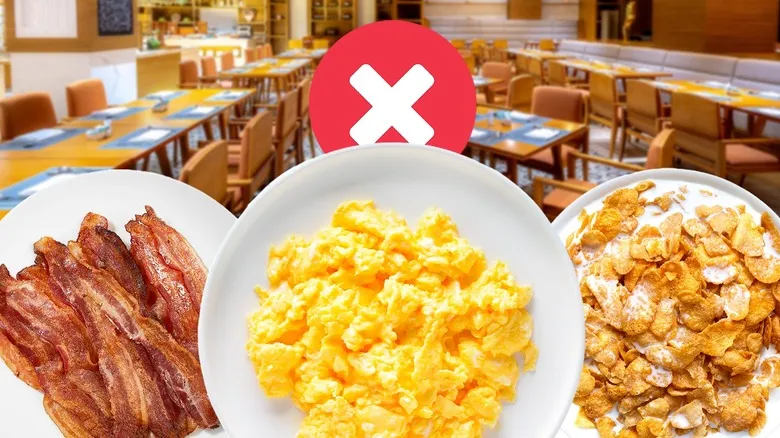What is a continental breakfast?

Before we explore the dos and don'ts of sausage patties and more, let's pause to consider: What exactly is a hotel continental breakfast? What distinguishes a continental breakfast from other complimentary meals? And, most importantly, why weren't we part of the world's largest continental breakfast hosted by Nutella in 2005? This event, held in Germany, set a Guinness World Record with 27,854 attendees, and honestly, we're feeling a bit of FOMO over here.
Now, back to the main question: What is a continental breakfast? Traditionally, it consists of lighter options such as coffee and tea, juice, yogurt, fruit, baked goods, and pastries with spreads. The term originated in 19th-century Britain, where this lighter fare was seen as a contrast to the hearty full English breakfast, which includes a hefty serving of beans, toast, sausages, eggs, and tomatoes.
The purpose of a continental breakfast is to provide sustenance while requiring minimal attention from hotel staff over several hours. However, as the concept of continental breakfasts has gained popularity, many hotels have expanded their offerings to include items like cheese, meats, bacon, chorizo, and other heavier foods. Upscale continental breakfasts may even feature meat and eggs. Unfortunately, these items are more susceptible to contamination, and even the traditional continental breakfast selections carry some risk.
Sausage or sausage patties

In films and television, when a character suffers from food poisoning, it’s often due to questionable meat selections. This trend exists for a good reason: undercooked, mishandled, or improperly stored meat is a leading cause of severe food poisoning. It can contain a range of harmful bacteria, including bacillus cereus, clostridium perfringens, E. coli, listeria, salmonella, and staphylococcus aureus. Fun times, right?
Unfortunately, sausage is not exempt from this risky meat category. One of the primary reasons it poses such a threat is that it is frequently stored at inappropriate temperatures—neither cold enough nor hot enough to inhibit bacterial growth. The United States Department of Agriculture states, "Bacteria thrive most quickly in temperatures between 40°F and 140°F, doubling in number in as little as 20 minutes."
As a result, hot foods carry a risk of foodborne illness if they aren’t maintained at a steady temperature above 140°F, which is not always guaranteed at a breakfast buffet. For this reason, you might consider bringing your thermometer or simply avoiding the sausage altogether.
Bacon

Similar to sausage, bacon poses a risk due to its ability to foster bacterial growth. As noted in the intriguingly titled peer-reviewed journal Meat Science, "The primary factor that facilitates rapid microbial proliferation on meats is their composition: 75% water along with various metabolites such as amino acids, peptides, nucleotides, and sugars." In simpler terms, it contains everything that harmful bacteria thrive on. When combined with the potential for improper temperature control, this creates a hazardous situation.
While bacon is enjoyable at nearly any temperature, it can begin to harbor bacteria just as quickly as sausage. Therefore, it's best to avoid consuming it unless it has just been served hot from the kitchen. Some individuals may have a higher tolerance for meat-related risks than others. However, children, the elderly, those with weakened immune systems, and pregnant individuals should exercise particular caution regarding meat that is undercooked, processed into spreads, cured, or left out at room temperature for extended periods.
Scrambled eggs
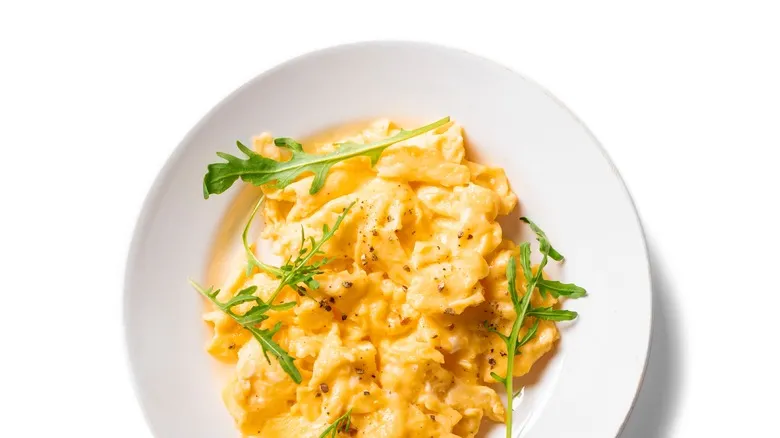
You might not find scrambled eggs in many hotels, particularly smaller ones where breakfast is offered in the lobby. However, larger hotels typically provide a range of egg options. It’s understandable that before spending a long day relaxing on the beach or engaging in team-building activities with new colleagues, it’s beneficial to have some protein. That said, you should reconsider eating scrambled eggs unless you see them being served fresh at the continental breakfast buffet.
The risk comes from the fact that eggs should be consumed right after they are cooked. If they aren’t, they need to be refrigerated immediately and then reheated to 165°F before serving. Take a guess at how often this protocol is followed at a continental breakfast buffet, where the idea is to eat at your convenience without waiting for specially prepared dishes.
Additionally, many hotels opt for powdered eggs. How you feel about this is a personal choice, but some sources indicate that the macronutrient profile of powdered eggs differs from that of fresh eggs.
Quiche

The same guidelines for scrambled eggs also apply to quiche: it should be served right away or refrigerated and then reheated to 165°F. However, unlike scrambled eggs, quiche is rarely eaten immediately after cooking; it often remains in questionable temperature conditions for extended periods and is frequently made with subpar ingredients. Additionally, industry advice suggests using older eggs for quiche, but busy hotel kitchens are unlikely to follow such specific recommendations.
Quiche poses even greater risks in warm environments. While the standard guideline is to keep egg dishes out for no more than two hours at room temperature, this time frame decreases to just one hour when temperatures reach 90°F or higher. This makes quiche a poor choice in hot climates. On a culinary note, hotel quiches tend to be dry, unexciting, and filled with leftover ingredients the restaurant wants to use up.
Condiments
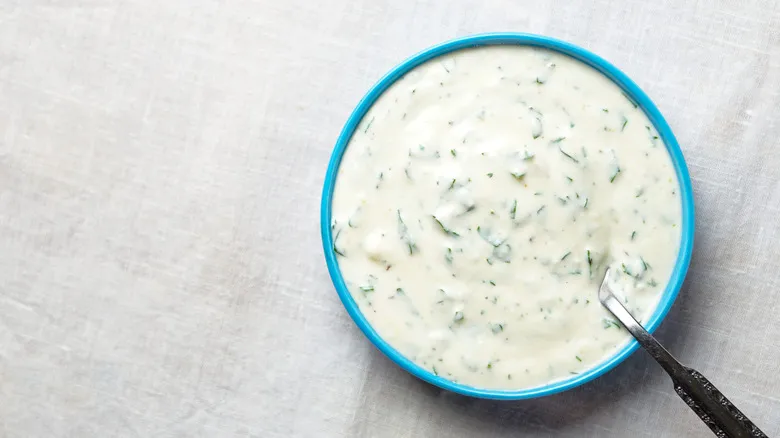
Condiments may appear to be a simple choice, and we’re all accustomed to using them at restaurant tables. While it’s true that some condiments are safer than others, research indicates that mustard and pickle relish can effectively eliminate salmonella bacteria due to their low pH (high acidity). In contrast, ketchup failed to kill salmonella for an entire day. Nevertheless, all three condiments are naturally acidic and rich in antimicrobial properties.
However, not all condiments are without risk. You might be surprised to learn that peanut butter can be problematic. Although it can be stored in your pantry, it’s not necessarily safe for the breakfast table. This is primarily due to its potential to harbor bacteria when contaminated, a situation that has occurred multiple times during production. Decontaminating peanut butter is challenging, so if it’s handled with unclean hands or shared utensils, the bacteria can remain. While its long shelf life may seem advantageous, it’s precisely because peanut butter can last so long without spoiling that foodborne bacteria can thrive.
Additionally, you should steer clear of open sauces or dips like guacamole, as they often remain in the danger zone for extended periods. Safer condiment choices include individually packaged items such as jams, butter cubes, peanut butter packets, and small containers of Nutella. Honestly, any opportunity to enjoy Nutella should be seized!
Room-temp milk or juice

While those charming vintage milk bottles on the buffet may catch your eye, it's wise to be cautious. The same goes for those delightful juice carafes that evoke memories of picturesque French hotels and Dutch terraces. They may be appealing and practical, but that doesn't guarantee their safety.
The real concern arises when foods that should be kept cold are stored above 40°F. This applies to all cold drinks at the continental breakfast buffet. Milk needs to be maintained at 40°F or lower and shouldn't be left out for more than two hours if it exceeds this temperature. If the surrounding temperature goes above 90°F, that time limit drops to just one hour. Juice has a slightly higher tolerance at 41°F, but it's still not ideal.
The issue is that while most hotels strive to keep milk and juice chilled, they may not always achieve the necessary temperatures. It's important to recognize that monitoring these heat and cold standards can be quite challenging for any establishment. With hot and cold foods often placed close together and a room full of people, maintaining the right temperature becomes even more difficult, creating a potential breeding ground for bacteria. If you can't see the milk and juice being served and confirm that they're adequately chilled, or if they're not on ice, it might be best to skip them.
Cut leafy greens

If you're puzzled and thinking, "Salad for breakfast?" you're not the only one. However, in Israel, where I've visited family multiple times, it's quite common to enjoy salad as part of the morning meal. Additionally, some breakfast sandwiches include greens, and small side salads are frequently served at brunch.
That said, it's best to avoid the salad bar at buffets whenever possible. Although they may seem tempting, chopped lettuce and other leafy greens can harbor serious pathogens, including norovirus, Shiga toxin-producing E. coli (STEC), campylobacter, and nontyphoidal salmonella. If that list gives you chills, you're not alone. While romaine lettuce is particularly notorious, all greens are at risk because they provide bacteria with an opportunity to thrive on moist surfaces that often aren't kept at low enough temperatures for food safety. If the greens aren't properly refrigerated or served on ice, it's best to steer clear.
Cut tomatoes

Tomatoes might not be the most typical breakfast food, but they are an essential component of the classic English breakfast and its Irish counterpart. They are also popular in countries where salads are a staple. Additionally, like lettuce, tomatoes frequently appear in breakfast sandwiches. However, similar to lettuce, they can pose a risk of salmonella if not stored at the correct temperature.
Despite their acidity, the cut surfaces of tomatoes can create a suitable environment for this potentially harmful bacteria, and the Food and Drug Administration has reported several cases over the years. For cut tomatoes, the safe temperature is 41°F or lower, so it's wise to avoid them unless they appear to be properly chilled. A good rule of thumb is to check if the tomatoes are placed on ice, which typically indicates they are being kept at the appropriate temperature.
Melon

Due to their durability when picked before fully ripe, melons are a popular choice at breakfast buffets. They are visually appealing and have a long shelf life, which is why many hotels routinely stock them. While melons are a well-deserved summertime favorite thanks to their soft texture and refreshing sweetness, it's important to remain cautious. If you can, consider alternatives.
Melons have been linked to health risks and were recently scrutinized by the Centers for Disease Control for their role in a salmonella outbreak. Spoiler alert: the melons were found to be the source. Although serious illness is uncommon, salmonella can lead to hospitalization and even death, making it a concern worth noting.
Sadly, melon rinds provide an ideal environment for bacteria to thrive. E. coli, listeria, and salmonella are frequently found on the rind. If a melon isn't cleaned properly, these pathogens can be transferred to the flesh when cut. Furthermore, if that contaminated melon is left at unsafe temperatures, it can quickly become hazardous. Whenever possible, opt for fruits that have a peel or rind for added safety.
Fruit salad
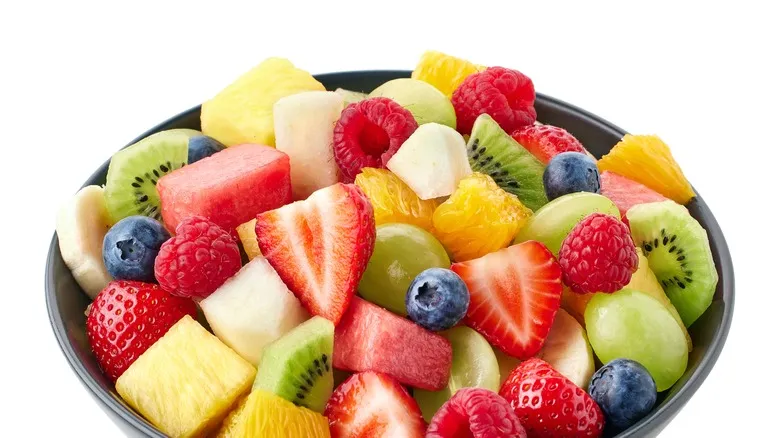
Not only is fruit salad often chopped and mixed, but it can also be risky. If you want to avoid food poisoning and make the most of your trip, it's best to steer clear of it at the breakfast buffet. Many fruit salads typically contain hardy melons, along with various other cut fruits. Unfortunately, improperly stored or washed fruit can harbor harmful bacteria, which can be transferred to the softer inner parts by knives. Additionally, fruit left out on a buffet line has a large exposed surface area, making it susceptible to pathogens like salmonella and listeria.
While fresh, vibrant, and shiny fruit salad is generally safer than mushy, dull, or discolored options, relying solely on smell to assess contamination is not advisable. As with many things in life, it often comes down to judgment. You're more likely to find quality fruit at a 5-star hotel than at a roadside Best Western. If possible, it's best to avoid the risk altogether and choose whole fruit that is in good condition or opt for fruit salad from bowls kept on ice.
Waffle batter

Absolutely, waffle stations can be a blast! And let's be honest, any reason to indulge in whipped cream is a valid one. However, it's important to note that the waffle batter used in continental breakfasts may not be as safe as you think. Unfortunately, I have to share some disappointing news: industry experts reveal that waffle batter isn't prepared fresh every day. Instead, hotel staff often mix new batter with old, sour batter to prolong its shelf life, sometimes until it starts to smell like beer, as noted by industry insider @brandaugustus on TikTok.
The downside? This practice can lead to bacterial growth. While bacteria typically begin to die off at around 150°F and waffle irons can reach temperatures of 375°F, there's no guarantee that all bacteria will be eliminated during cooking—especially on the inside of your waffle. Additionally, the waffle maker itself may not be properly cleaned, and leftover food can harbor bacteria, not to mention potential pests. If you're craving waffles, you might want to consider heading out for brunch instead!
Cereal
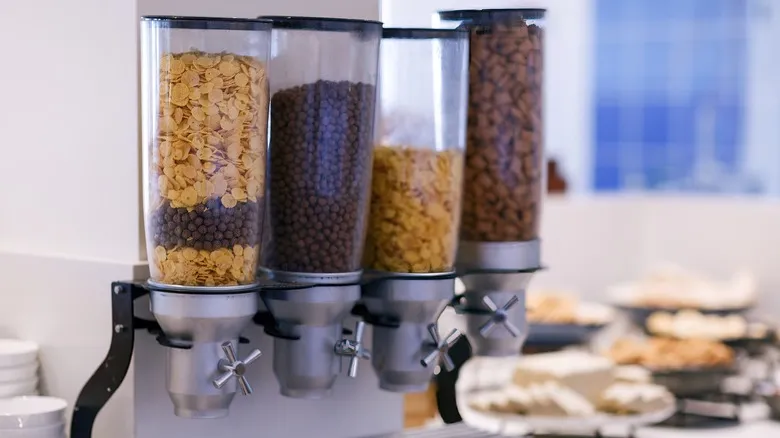
Unlike some other items on this list, cereal is unlikely to upset your stomach. It’s dry and has a long shelf life, making it a poor environment for bacteria to thrive. Typically, it’s dispensed from a machine or packaged in single servings, which further protects it (and you) from contamination. So, if you’re on vacation and worried about your food choices, cereal can be a safe option.
However, many continental breakfast buffets don’t provide healthy, low-sugar cereal alternatives. You’ll often find sugary varieties like Lucky Charms, Frosted Flakes, or Froot Loops. Even cereals that sound less sugary can contain surprisingly high amounts of sugar, especially considering they are often given to children. If cereal is your only option, opt for choices like shredded wheat or raisin bran, which are more likely to keep you satisfied throughout the day, whether for work or leisure.
Ideally, though, you should consider skipping cereal altogether. Whenever possible, steer clear of other high-sugar items typically available, such as packaged pastries, high-calorie yogurt, and waffles. Instead, look for nutritious options like hard-boiled eggs and plain yogurt.
Bowls that require you to grab by hand

Now, for a bit of added excitement, let’s revisit the subject of hepatitis A! See, that’s already a fun twist. However, the reality is that hepatitis A is a serious issue. While it typically resolves on its own within a few months, there is no specific treatment, and it can pose significant risks for the elderly and individuals with liver issues. Even more concerning, it can be transmitted from unwashed hands to prepared food, with such transmission accounting for 2% to 3% of cases.
Thus, your new motto should be "No utensil? No way." Bowls filled with large quantities of items (like pastries, rolls, and pieces of fruit) may appear safe, but they are not. When people grab food with their hands, they often touch items they don’t take, leaving you uncertain about their hygiene practices. If you can’t rely on restaurant staff to maintain proper handwashing, you certainly can’t trust the general public. Stick to using tongs, end of story.
Recommended

Melissa Clark's Tip For Freezing Sauces Saves A Ton Of Freezer Space

The Right Way To Freeze Cake (And Make Frosting It Even Easier)

How Martha Stewart Saves Parmesan Cheese That Was Stored Incorrectly

The Tuberculosis Risk Behind TikTok's Beloved Raw Milk
Next up

